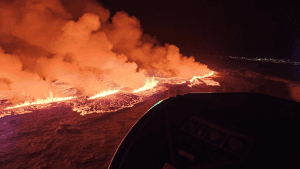TAG: GS 3: ECOLOGY AND ENVIRONMENT
THE CONTEXT: The recent volcanic eruption that commenced near Grindavik in Iceland has raised concerns, but the Icelandic government has assured that it does not pose an immediate threat to life.
EXPLANATION:
- This eruption, which initiated on December 18th local time, is situated between Sýlingarfell and Hagafell, north of Grindavik—a town located on the Reykjanes Peninsula in the southwest of Iceland.

Eruption Details and Population Impact
- Location and Proximity:
- The eruption site lies in close proximity to the Icelandic capital, Reykjavik, which houses a significant portion of the country’s population.
- Evacuation and Precautions:
- The 3,800 residents of Grindavik had previously been evacuated on November 10 due to escalating seismic activity.
- President emphasized the need to safeguard lives and infrastructure in his communication, highlighting the closure of the affected area and the nation’s preparedness to face the natural forces.
Geological Significance of Iceland: ‘Land of Fire and Ice’
- Mid Atlantic Ridge:
- Iceland’s unique geological position atop the Mid Atlantic Ridge, the meeting point of the North American and Eurasian tectonic plates, fosters its distinct landscape.
- Natural Features:
- The country’s terrain showcases an amalgamation of geysers, glaciers, mountains, volcanoes, and lava fields, earning it the moniker ‘Land of Fire and Ice.’
- Volcanic Activity:
- Iceland is home to 33 active volcanoes, reflecting a significant concentration of volcanic activity, notably the highest in Europe.
Historical Context and Recent Eruption Trends
- Reykjanes Peninsula:
- The region hadn’t witnessed volcanic eruptions for nearly 800 years before experiencing four eruptions within a span of fewer than three years, hinting at a potential new phase of volcanic activity.
- Eyjafjallajokull Eruption:
- The last globally significant eruption in Iceland occurred in 2010, when Eyjafjallajokull’s eruption disrupted air traffic across Europe and North America for six days due to an extensive ash cloud.
Expert Opinions and Potential Impact on Air Travel
- Experts noted that while the possibility of air travel disruptions due to the current eruption is unlikely, it remains a potential concern.
- The impact on air travel might occur but isn’t guaranteed at this point.
Conclusion
- The ongoing eruption near Grindavik, Iceland, raises awareness of the country’s unique geological features and its susceptibility to volcanic activity.
- While the current eruption doesn’t pose an immediate threat to life, the historical context of Icelandic eruptions, along with expert insights, underscores the need for vigilance and preparedness for potential impacts, including on air travel.
FOR MORE INFORMATION, PLEASE REFER TO THE 14TH NOVEMBER 2023 DNA.
Spread the Word

Related posts
GST 2.0-NEXT‑GEN GST
French System of government and its comparison with India
A CASE OF EMPATHY: THE SC TO THE SOLDIER’S RESCUE